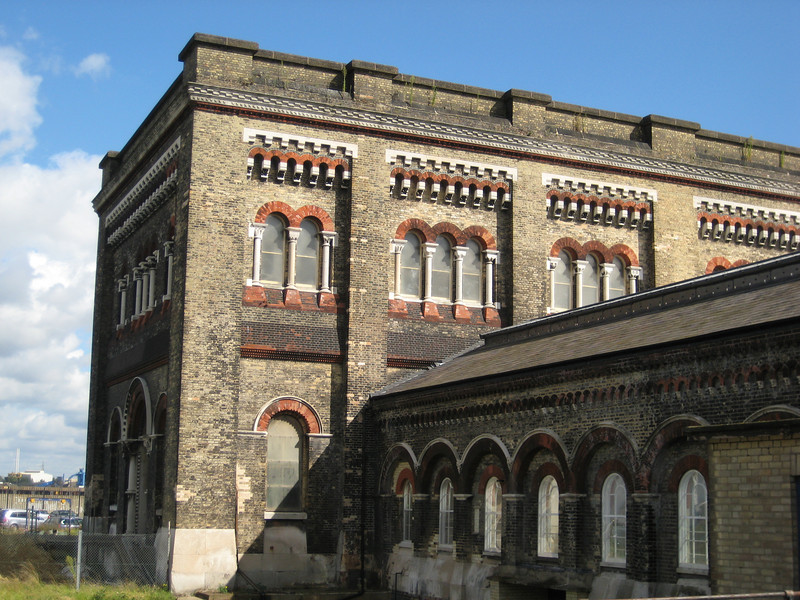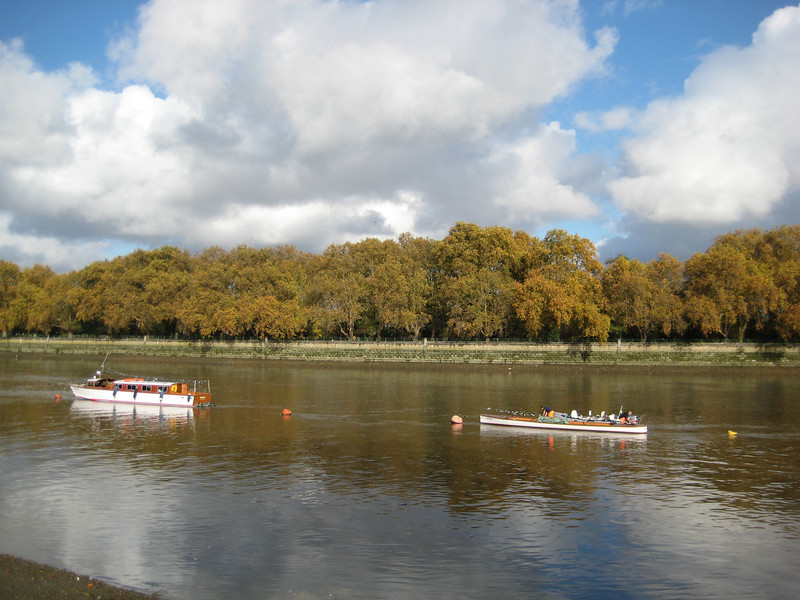One of the few places in London that I really wanted to go to the last time I was here & didn’t get the opportunity to was the Crossness Beam Engines. As this great example of Victorian engineering is still undergoing extensive restoration work, there are very few days this year that one can go & visit & see an engine in operation. But today, as part of Open London (an annual weekend when a lot of London’s great architecture that is usually off limits to the public is opened up) the complex was open & welcoming visitors. What a lot of visitors there were – we queued patiently for about an hour just to get in. Who would have thought so many people would turn up to the site on the side of a huge sewage works in south-east London?
A brief history lesson – in the early half of the nineteenth century, rapidly expanding & industrialising London did not have a central sewage system & almost all waste from over 200000 cesspits was discharged into the Thames (“dump her in the Thames?”) system. Unfortunately, the Thames at high tide (it really is surprising just how far the tide flows up the river – well out west) had a habit of returning that sewage to where it came from. Even worse, the Thames was still the main supply of water to the city! Outbreaks of cholera & typhoid were, in hindsight, hardly surprising. Eventually, mid-century, a plan was devised & put in to action to deal with the problem. Basically, a two sewerage systems independent of each other were built on either side of the river. These used gravity to move all of the sewerage to the east of the city, where it was then discharged to the Thames. In the last four years of the 1850s, over eighty miles of brick intercepting sewers were built (using 318 million bricks!) & this is also the reason we have the Victoria & Albert Embankments today.
But the problem of preventing the sewage coming back into the city on the tide still had to be overcome. This is where the pumping stations came in – one at Crossness (south) & the other at Abbey Mills (north) were used to pump the sewage up to large reservoirs. From the reservoirs, the sewage was released on the outgoing tide. There was no treatment initially, later settling ponds were introduced & the solids were shipped out to sea & dumped there. The pumping station at Crossness had twelve boilers powering four large rotative beam engines. Each engine had two pumps attached to the beam & at peak they could move over 500 tonnes of sewage a minute. That was after a retrofit, changing the engines from single-cylinder to triple-expansion (high, intermediate & low pressure cylinders). The engines were superseded by diesel & eventually left to decay & vandalism for thirty years from the mid 1950s. I’m sure the restorers are also stoked that someone had the foresight to fill the engine area up with sand to prevent methane accumulating – they’ve had to remove a hundred tonnes just to restore the first engine.
Being built by the Victorians, the building & fittings are fantastic. But the real star is the fully restored Prince Consort engine operating under steam. The flywheel is almost nine metres in diameter & has a mass of over fifty tonnes. The beam is almost fourteen metres long & forty-seven tonnes heavy. It was surprisingly quiet as all the valves opened & closed in time to drive that massive beam up & down. It was well worth the wait to get in as one could wander around at leisure poking around not only the restored Prince Consort, but Victoria (which they are starting to restore now) & the still derelict Albert Edward & Alexandra engines. All the volunteers were friendly, knowledge & some were in period dress which added to the old time feel of the place. It was a great few hours out & I particularly enjoyed marvelling at the feat of engineering from 150 years ago & seeing the Prince Consort engine all painted up & effortlessly gliding through its cycle.
 Engine house at rear, boiler house in foreground
Engine house at rear, boiler house in foreground
 The brickwork was exceptional all the way around
The brickwork was exceptional all the way around
 The Prince Consort’s flywheel – note the trimming on the guard rail
The Prince Consort’s flywheel – note the trimming on the guard rail
 Looking up to the Prince Consort’s beam – flywheel connecting rod in front of pump connecting rods
Looking up to the Prince Consort’s beam – flywheel connecting rod in front of pump connecting rods
 Counter beam on left, top of the low & intermediate cylinders
Counter beam on left, top of the low & intermediate cylinders
 End of the main beam looking down on top of drive cylinders
End of the main beam looking down on top of drive cylinders
 More superb Victorian detailing
More superb Victorian detailing
 Unrestored beams
Unrestored beams

 Just in case there’s anyone left wondering how this thing worked
Just in case there’s anyone left wondering how this thing worked
Just in case there’s anyone left wondering how this thing worked
The rest of my photos from the visit are here. I left wishing I didn’t have a gammy shoulder & was staying around here a bit longer so that I might volunteer a bit – a fantastic historical project all round.
 Some sort of Czech food that was very tasty
Some sort of Czech food that was very tasty Levi & Marki – on the remote chance any TP people are interested
Levi & Marki – on the remote chance any TP people are interested





 Less than three-hundred days until the next Olympics
Less than three-hundred days until the next Olympics

 Engine house at rear, boiler house in foreground
Engine house at rear, boiler house in foreground The brickwork was exceptional all the way around
The brickwork was exceptional all the way around The Prince Consort’s flywheel – note the trimming on the guard rail
The Prince Consort’s flywheel – note the trimming on the guard rail Looking up to the Prince Consort’s beam – flywheel connecting rod in front of pump connecting rods
Looking up to the Prince Consort’s beam – flywheel connecting rod in front of pump connecting rods Counter beam on left, top of the low & intermediate cylinders
Counter beam on left, top of the low & intermediate cylinders End of the main beam looking down on top of drive cylinders
End of the main beam looking down on top of drive cylinders More superb Victorian detailing
More superb Victorian detailing Unrestored beams
Unrestored beams
 Just in case there’s anyone left wondering how this thing worked
Just in case there’s anyone left wondering how this thing worked